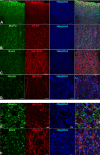Tissue Engineered Neural Constructs Composed of Neural Precursor Cells, Recombinant Spidroin and PRP for Neural Tissue Regeneration
- PMID: 30816182
- PMCID: PMC6395623
- DOI: 10.1038/s41598-019-39341-9
Tissue Engineered Neural Constructs Composed of Neural Precursor Cells, Recombinant Spidroin and PRP for Neural Tissue Regeneration
Abstract
We have designed a novel two-component matrix (SPRPix) for the encapsulation of directly reprogrammed human neural precursor cells (drNPC). The matrix is comprised of 1) a solid anisotropic complex scaffold prepared by electrospinning a mixture of recombinant analogues of the spider dragline silk proteins - spidroin 1 (rS1/9) and spidroin 2 (rS2/12) - and polycaprolactone (PCL) (rSS-PCL), and 2) a "liquid matrix" based on platelet-rich plasma (PRP). The combination of PRP and spidroin promoted drNPC proliferation with the formation of neural tissue organoids and dramatically activated neurogenesis. Differentiation of drNPCs generated large numbers of βIII-tubulin and MAP2 positive neurons as well as some GFAP-positive astrocytes, which likely had a neuronal supporting function. Interestingly the SPRPix microfibrils appeared to provide strong guidance cues as the differentiating neurons oriented their processes parallel to them. Implantation of the SPRPix matrix containing human drNPC into the brain and spinal cord of two healthy Rhesus macaque monkeys showed good biocompatibility: no astroglial and microglial reaction was present around the implanted construct. Importantly, the human drNPCs survived for the 3 month study period and differentiated into MAP2 positive neurons. Tissue engineered constructs based on SPRPix exhibits important attributes that warrant further examination in spinal cord injury treatment.
Conflict of interest statement
The authors declare no competing interests.
Figures









Similar articles
-
Polycaprolactone/polysialic acid hybrid, multifunctional nanofiber scaffolds for treatment of spinal cord injury.Acta Biomater. 2018 Sep 1;77:15-27. doi: 10.1016/j.actbio.2018.06.038. Epub 2018 Jul 3. Acta Biomater. 2018. PMID: 30126591
-
Polycaprolactone electrospun fiber scaffold loaded with iPSCs-NSCs and ASCs as a novel tissue engineering scaffold for the treatment of spinal cord injury.Int J Nanomedicine. 2018 Oct 10;13:6265-6277. doi: 10.2147/IJN.S175914. eCollection 2018. Int J Nanomedicine. 2018. PMID: 30349249 Free PMC article.
-
In Vitro Study of Human Immune Responses to Hyaluronic Acid Hydrogels, Recombinant Spidroins and Human Neural Progenitor Cells of Relevance to Spinal Cord Injury Repair.Cells. 2021 Jul 6;10(7):1713. doi: 10.3390/cells10071713. Cells. 2021. PMID: 34359882 Free PMC article.
-
Biomimetic engineered approaches for neural tissue engineering: Spinal cord injury.J Biomed Mater Res B Appl Biomater. 2023 Mar;111(3):701-716. doi: 10.1002/jbm.b.35171. Epub 2022 Oct 10. J Biomed Mater Res B Appl Biomater. 2023. PMID: 36214332 Review.
-
Hyaluronic Acid Biomaterials for Central Nervous System Regenerative Medicine.Cells. 2020 Sep 17;9(9):2113. doi: 10.3390/cells9092113. Cells. 2020. PMID: 32957463 Free PMC article. Review.
Cited by
-
Spidroin Silk Fibers with Bioactive Motifs of Extracellular Proteins for Neural Tissue Engineering.ACS Omega. 2021 May 30;6(23):15264-15273. doi: 10.1021/acsomega.1c01576. eCollection 2021 Jun 15. ACS Omega. 2021. PMID: 34151105 Free PMC article.
-
Platelet-Rich Plasma Therapy in the Treatment of Diseases Associated with Orthopedic Injuries.Tissue Eng Part B Rev. 2020 Dec;26(6):571-585. doi: 10.1089/ten.TEB.2019.0292. Epub 2020 Nov 3. Tissue Eng Part B Rev. 2020. PMID: 32380937 Free PMC article. Review.
-
Platelet-Rich Plasma in Regenerative Medicine: Possible Applications in Management of Burns and Post-Burn Scars: A Review.Cell J. 2023 May 28;25(5):281-290. doi: 10.22074/cellj.2023.558213.1093. Cell J. 2023. PMID: 37300289 Free PMC article.
-
Harnessing the power of artificial intelligence for human living organoid research.Bioact Mater. 2024 Aug 30;42:140-164. doi: 10.1016/j.bioactmat.2024.08.027. eCollection 2024 Dec. Bioact Mater. 2024. PMID: 39280585 Free PMC article. Review.
-
Application of platelet-rich plasma in spinal surgery.Front Endocrinol (Lausanne). 2023 Mar 15;14:1138255. doi: 10.3389/fendo.2023.1138255. eCollection 2023. Front Endocrinol (Lausanne). 2023. PMID: 37008931 Free PMC article. Review.
References
Publication types
MeSH terms
Substances
LinkOut - more resources
Full Text Sources
Other Literature Sources
Medical
Research Materials
Miscellaneous

